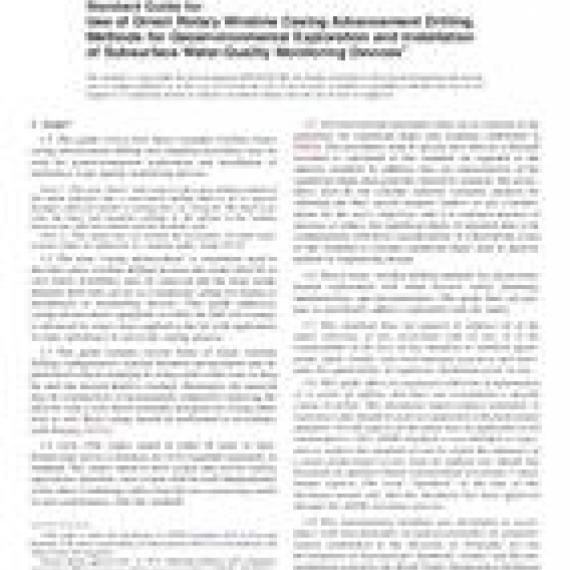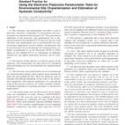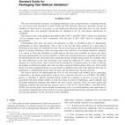No products
ASTM D5876/D5876M-17
ASTM D5876/D5876M-17 Standard Guide for Use of Direct Rotary Wireline Casing Advancement Drilling Methods for Geoenvironmental Exploration and Installation of Subsurface Water-Quality Monitoring Devices
standard by ASTM International, 12/15/2017
Full Description
1.1This guide covers how direct (straight) wireline rotary casing advancement drilling and sampling procedures may be used for geoenvironmental exploration and installation of subsurface water-quality monitoring devices.
Note 1:The term direct with respect to the rotary drilling method of this guide indicates that a water-based drilling fluid or air is injected through a drill-rod column to rotating bit(s) or coring bit. The fluid or air cools the bit(s) and transports cuttings to the surface in the annulus between the drill rod column and the borehole wall.
Note 2:This guide does not include the procedures for fluid rotary systems which are addressed in a separate guide, Guide D5783.
1.2The term casing advancement is sometimes used to describe rotary wireline drilling because the center pilot bit or core barrel assemblies may be removed and the large inside diameter drill rods can act as a temporary casing for testing or installation of monitoring devices. This guide addresses casing-advancement equipment in which the drill rod (casing) is advanced by rotary force applied to the bit with application of static downforce to aid in the cutting process.
1.3This guide includes several forms of rotary wireline drilling configurations. General borehole advancement may be performed without sampling by using a pilot roller cone or drag bit until the desired depth is reached. Alternately, the material may be continuously or incrementally sampled by replacing the pilot bit with a core-barrel assembly designed for coring either rock or soil. Rock coring should be performed in accordance with Practice D2113.
1.4Units-The values stated in either SI units or Inch-Pound units given in brackets are to be regarded separately as standard. The values stated in each system may not be exactly equivalents; therefore, each system shall be used independently of the other. Combining values from the two system may result in non-conformance with the standard.
1.5All observed and calculated values are to conform to the guidelines for significant digits and rounding established in D6026. The procedures used to specify how data are collected/recorded or calculated in this standard are regarded as the industry standard. In addition, they are representative of the significant digits that generally should be retained. The procedures used do not consider material variation, purpose for obtaining the data, special purpose studies, or any considerations for the users objective; and it is common practice to increase or reduce the significant digits of reported data to be commensurate with these considerations. It is beyond the scope of this standard to consider significant digits used in analysis method or engineering design.
1.6Direct rotary wireline drilling methods for geoenvironmental exploration will often involve safety planning, administration, and documentation. This guide does not purport to specifically address exploration and site safety.
1.7This standard does not purport to address all of the safety concerns, if any, associated with its use. It is the responsibility of the user of this standard to establish appropriate safety, health, and environmental practices and determine the applicability of regulatory limitations prior to use.
1.8This guide offers an organized collection of information or a series of options and does not recommend a specific course of action. This document cannot replace education or experience and should be used in conjunction with professional judgment. Not all aspects of this guide may be applicable in all circumstances. This ASTM standard is not intended to represent or replace the standard of care by which the adequacy of a given professional service must be judged, nor should this document be applied without consideration of a project's many unique aspects. The word Standard in the title of this document means only that the document has been approved through the ASTM consensus process.
1.9This international standard was developed in accordance with internationally recognized principles on standardization established in the Decision on Principles for the Development of International Standards, Guides and Recommendations issued by the World Trade Organization Technical Barriers to Trade (TBT) Committee.


































